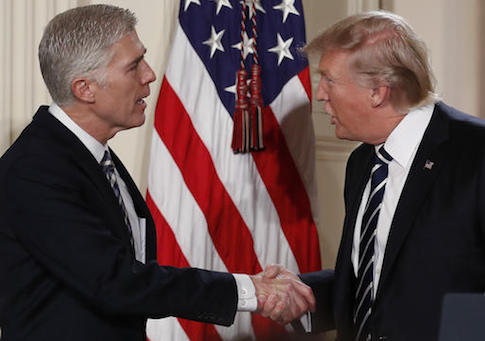President Donald Trump is positioned to potentially appoint more federal judges to the bench than any first-term president in 40 years due to several vacancies on federal courts and a growing number of older judges.
There are 870 federal court judgeships established under Article III of the Constitution that are appointed by the president, of which all but a few judges can serve lifetime terms. The majority of these judgeships are on district or appeals courts.
As Trump begins his presidency, 12 percent of the federal judiciary's seats are vacant, and 24 percent are eligible for "senior status," a kind of semi-retirement that judges reach with a combination of age and years served on the bench, the New York Times reported Tuesday. A seat becomes vacant once the judge who occupies it enters "senior status."
There has never been a greater proportion of federal judgeships in "senior status" since at least Gerald Ford was president in the 1970s, and over the same four-decade period, only Bill Clinton had a higher percentage of total vacant seats.
The current median age of the federal judiciary is 62.6, also the highest since Ford. Thirty-eight percent of the seats are expected to become vacant, by far the biggest percentage in about 40 years.
When former President Jimmy Carter took office in January 1977, Congress established 152 federal judgeships, expanding the judiciary by almost 30 percent. This judiciary expansion allowed Carter to stack the federal courts, although his presidency only lasted one term. Trump is expected to get this same benefit during his first term, despite many Democrats accusing Republicans of obstructing judicial nominees during the last year of former President Barack Obama's second term in office, the Times reported.
Democrats have long accused Republican Senate leaders of obstruction in not allowing many of the previous administration's judicial nominees to come to a vote. The most prominent example was the refusal to vote on Judge Merrick Garland's nomination to the Supreme Court, but the tactic extended to Mr. Obama's lower court nominees as well.
"Right off the bat, Republicans refused to approve anyone," Nan Aron, president of the liberal group Alliance for Justice, told the Times. "So you know how important this is to the Republican Party."
John Malcolm, director of the conservative Heritage Foundation's Center for Legal and Judicial Studies, agreed with Aron's assessment and said that Trump has been given "quite the opportunity." He also noted that Trump would have nearly twice the number of vacancies on the federal bench as Obama when he took office in 2009–about an eighth of the judiciary.
There are currently 112 authorized judgeships with lifetime appointments that remain vacant out of the 870 total, 33 of which have been vacant for over two years.
During Obama's two terms in office, he appointed nearly 40 percent of the federal judiciary. As of last February, Obama's pace of appointing women and minorities to judgeships increased to the point that white men no longer represented a majority of the federal judges, the Times reported.
"This was absolutely astonishing," said Sheldon Goldman, a professor of political science at the University of Massachusetts Amherst and an expert in presidential nominees to the federal courts. "White males have overwhelmed the judiciary in the past."
At the same time, the tenor of the courts changed. While taking care to clarify that Mr. Obama had appointed "a number of outstanding judges," Mr. Malcolm criticized what he viewed as "a large ideological shift on the circuit courts." This led, he said, to a wave of progressive circuit court decisions and fewer splits in the circuit courts (making Supreme Court review less likely).
An ideological litmus test has not been publicly set by Trump or his staff for judicial appointments, so it is unclear who will be appointed to the judgeships.
"The appointment of judges is typically a three-legged stool," Malcolm said, noting that guidance comes from home state senators, the White House counsel's office, and someone in the Justice Department, usually from the Office of Legal Policy. "How the power balance shifts among these three points varies somewhat from administration to administration."
Once the Trump administration starts nominating judges, they can be confirmed with a simple majority in the Republican-controlled Senate. This is a much easier process for judges to get confirmed since the Senate eliminated the filibuster during approval votes in 2013 for lower court judges.
